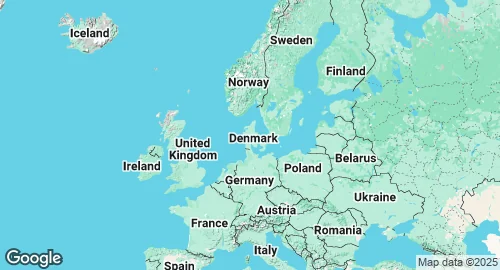Denmark Military Forces 🇩🇰
Military Strength Overview
| 🛩️ Air Force | 111 active aircraft |
| ⚓️ Naval forces | 127 ships in fleet |
| 🪖 Active Troops | 14,500 personnels |
| ⛑️ Reserve Troops | 44,000 personnels |
| 🎖️ Military ranks | 60 ranks listed |
Defense Statistics & Key Metrics
| Population | 5.9 million (2023) |
| GDP | $407.1 billion (2023) |
| GDP per capita | $68454 (2023) |
| Military Budget | $10.0 billion (2024) |
| Share of GDP in Milex | 2.4% (2024) |
| Share of Govt Expenditures | 5.1% (2024) |
| Military spends per capita | $1670 (2024) |
| Inflation Rate | 1.37% (2024) |
| Military Personnel | 15,000 (2020) |
Strategic Overview in 2025
Denmark, a founding member of NATO, holds a strategically significant position as the gateway to the Baltic Sea and as a sovereign power in the North Atlantic and Arctic through its territories of Greenland and the Faroe Islands. Historically a proponent of a "low tension" approach in the Arctic, the war in Ukraine has catalyzed a significant shift in Danish defense policy. This has resulted in a surge in defense spending, with commitments to exceed 2% of GDP, and a renewed focus on collective defense and deterrence. Denmark's strategic importance often allows it to 'punch above its weight' in international affairs.
Military Forces
The Danish Armed Forces are a relatively small but modern and technologically advanced force, structured for both national defense and expeditionary operations within a NATO framework. The active force is supplemented by a large reserve and the volunteer Home Guard.
- The Royal Danish Army is equipped with modern hardware, including Leopard 2A5 main battle tanks and CV90 infantry fighting vehicles. It is undergoing modernization to replace aging armored personnel carriers.
- The Royal Danish Navy is a key component of Denmark's military, reflecting the nation's maritime identity. It operates advanced warships such as the Iver Huitfeldt-class air defense frigates and the flexible Absalon-class command and support ships, designed with modular containerized systems for mission versatility.
- The Royal Danish Air Force is in transition, replacing its fleet of F-16s with the F-35A Lightning II, a move that will significantly enhance its offensive and defensive capabilities and ensure interoperability with key allies.
Defense Industry and Strategic Trends
Denmark's defense industry is highly specialized and export-oriented. Rather than producing large platforms independently, Danish companies excel in providing high-tech subsystems and components. Key specializations include maritime technology, advanced radar systems, and command-and-control (C4ISR) systems. Danish firms are integral to global defense supply chains, most notably in the F-35 program, for which they manufacture critical components. The United States is the primary export market for the Danish defense industry.
Copenhagen's primary strategic challenges and trends are shaped by Russian aggression and great power competition in the Arctic. In response, Denmark is making substantial investments in its Arctic and North Atlantic capabilities. This includes acquiring new long-range drones, satellite surveillance capabilities, and new naval vessels to enhance its presence and situational awareness in the region, particularly around Greenland and the Faroe Islands. A key priority is strengthening cooperation with Nordic and other NATO allies to present a united front and deter potential adversaries. This shift marks a more assertive Danish security and defense posture for the foreseeable future.
Danish Military Budget History
Population and Military Personnel Trends
GDP and Inflation Rate Trends
Danish Naval Shipbuilding
| Class | Type |
|---|---|
| Absalon | Frigate |
| Ægir | Offshore patrol vessel |
| Agdlek | Cutter |
| Diana | Patrol Craft |
| Flyvefisken | Patrol vessel |
| Iver Huitfeldt | Air Defense Frigate |
| Thetis | Multi-role ocean patrol vessel |
Danish Firearms Development
| Model | Category |
|---|---|
| Madsen M/50 | Submachine gun |
Military Expenditure: SIPRI Milex.
